2020年高考英语外刊时事命题阅读理解
- 格式:doc
- 大小:2.18 MB
- 文档页数:7

China builds new hospital in10days to combat coronavirus中国速度,火神山医院和雷神山医院建成记The Chinese philosopher(哲学家)Confucius once said,“Time flows away like the water in the river.”This is especially true as the novel coronavirus pneumonia outbreak has affected millions of people in China,and the whole nation has been working day and night to fight the epidemic.In late January when an increasing number of people in Wuhan were suspected to be infected,and hospitals didn’t have adequate beds for them,two special hospitals –Leishenshan Hospital and Huoshenshan Hospital–were built.These two makeshift(临时的)hospitals were built to treat pneumonia patients infected with the novel coronavirus.Huoshenshan Hospital has1,000beds and covers 33,900square meters,and Leishenshan Hospital has1,500beds and a total area of about79,000square meters.More than4,000workers worked24/7in two shifts,and nearly1,000large-scalepieces of equipment and transport vehicles helped the project on-site.The two hospitals were built in an amazingly short time.It only took10days for people to build Huoshenshan,and14days for lions of Chinese people watched livestreamed(直播)videos of the construction.This certainly wowed many people overseas.“It’s incredible that two hospitals with2,500beds can be built in a short period.It’s just hard to believe,”a foreigner named Stuart told People’s Daily.“This project shows us that China is a great nation with solidarity(团结),”a Chinese internet user commented on Sina Weibo.In the meantime,Chinese companies have also taken actions quickly in this battle.According to China Daily,some Chinese companies which have nothing to do with medical supplies have changed their factories to churn out masks,the most-needed“weapon”for the public’s defense.Local automobile maker BYD,for example,started producing masks on Feb8 and launched them on Feb17.The first batch(一批)of these masks was donated to drivers of public buses,taxis as well as volunteers fighting the viral outbreak.“The automobile industry is highly industrialized with strong capabilities in comprehensive manufacturing,purchasing materials,production lines and output of technologies,”Shi Jianhua,deputy secretary-general of China Association of Automobile Manufacturers,told CCTV News.“In this special time,when the nation needs more masks,it’s time for us to quickly respond and shoulder the social responsibilities.”Indeed,a fast response is crucial(重要的)in any crisis.In this special time, China can’t afford to waste a second in the fight against the epidemic.After all,time equals life during this crisis.(选自Newyork Times)1.The project of the two makeshift hospitals amazed the world because of ________.A.the high cost of completing themB.the efficiency in which they were builtC.The support they received from home and abroadD.the livestreamed videos used to track their construction2.What does the underlined phrase“churn out”in Paragraph7probably mean?A.collect a large amount of somethingB.save something for future useC.produce large amounts of something quicklyD.sell something at a low price3.What is the author’s intention of introducing the automobile industry in the text?A.To inform us of its advanced technologies.B.To explain what it can do to help fight the virus.C.To show that it should have contributed more to the fight.D.To prove that different industries have united to fight the virus.译文:中国哲学家孔子曾经说过:“时间像河里的水一样流逝。

Sign of the Times在“大数据”的“加持”下,户外广告牌焕发新生。
PEDESTRIANS walking down 8th Avenue in Manhattan’s Hell’s Kitchen neighborhood will be struck by the face-side(正面) of the Hearst Magazine Building. The 3,716-square-metre building is decorated with columns and statues, and topped by a 183-meter glass and steel skyscraper.{1} Another distinctive feature is a vast digital screen that transmits advertisements. Despite being one of the world’s oldest forms of marketing, the outdoor-advertising business is embracing digital technologies.Most forms of traditional advertising — print, radio and broadcast television — have been losing ground to online ads for years. Only billboards, dating back to the 1800s, and TV ads are holding their own (see chart below). Out-of-home (OOH) advertising is estimated to have grown by 3.4 percent in 2018; digital out-of-home (DOOH) advertising, which includes the LCD screens (液晶屏) found in airports and shopping malls, by 16 percent. Such ads draw viewers’ attentionfrom phones and cannot be skipped or blocked, unlike ads online.Billboard owners are also making hay from the location data that are pouring off people’s smartphones.{2} Information about their owners’ whereabouts and online browsing gets collected and anonymized (匿名处理) by carriers (运营商) and data firms, and sold to media owners. They then use these data to work out when different groups — say, business travelers — walk by their ads. That knowledge is added to insights into traffic, weather and other data to produce highly relevant ads. For example, DOOH providers can deliver ads for coffee when it is cold.Billboards can also be programmed to show ads for allergy (过敏症) medication when the air is full of pollen(花粉).Such targeting works particularly well when it is accompanied by “programmatic” advertising methods. Supporters say outdoor ads will increasingly be bought like online ones, based on audience and views as well as location.That is possible because billboard owners claim to be able to measure how well their ads are working, even though no “click-through” rates are involved. Data firms can tell advertisers how many people walk past individual advertisements at particular times of the day. Advertisers can estimate how many individuals exposed to an ad go on to visit a nearby shop (or website) and buy the product. Such metrics (指标) make outdoor ads more data-driven, automated and measurable.Tech giants are among those to see more value in outdoor advertising. Netflix acquired a series of billboards along Hollywood’s Sunset Strip, where it advertises its films and TV shows. Tech firms, including Apple and Google, are heavy buyers of OOH ads, accounting for 25 of the top 100 OOH ad spenders in America.The outdoor-ad revolution is not problem-free, however. The collection of mobile phone data raises privacy concerns. And criticisms of the online-ad business may also turn to the OOH business as it becomes bigger and more complex. One of the benefits of following the online-ad leaders is that the OOH advertisers can learn from their mistakes.(选自Economist)1. The underlined words in Paragraph 3 probably mean “______.”A. restricting access toB. earning a profit fromC. taking advantage ofD. finding fault with2. According to the article, which of the following statements is true?A. The billboard has a history of more than 300 years.B. The billboard is the only form of conventional advertising that winsagainst online ads.C. DOOH refers to any type of digital billboards used for advertising outdoors.D. It is estimated that OOH advertising grew slower than DOOH advertising in 2018.3. What can we infer from the article?A. Billboard advertising is more likely to be targeted toward business travelers.B. “Click-through” rates are the only reliable metrics in advertising.C. Tech giants invest more money in OOH ads than in online ones.D. The outdoor-ad industry is likely to address privacy concerns.译文:沿着曼哈顿地狱厨房街区的第八大街行走的PEDESTRIANS将被赫斯特杂志大楼正面遮住。
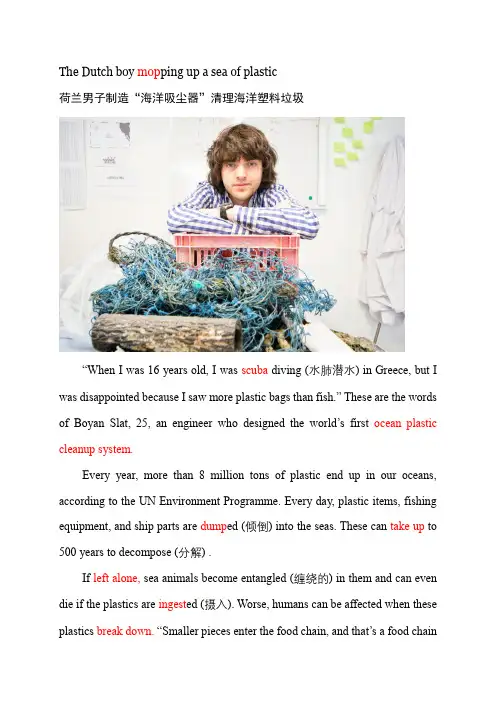
The Dutch boy mop ping up a sea of plastic荷兰男子制造“海洋吸尘器”清理海洋塑料垃圾“When I was 16 years old, I was scuba diving (水肺潜水) in Greece, but I was disappointed because I saw more plastic bags than fish.” These are the words of Boyan Slat, 25, an engineer who designed the world’s first ocean plastic cleanup system.Every year, more than 8 million tons of plastic end up in our oceans, according to the UN Environment Programme. Every day, plastic items, fishing equipment, and ship parts are dump ed (倾倒) into the seas. These can take up to 500 years to decompose (分解) .If left alone, sea animals become entangled (缠绕的) in them and can even die if the plastics are ingest ed (摄入). Worse, humans can be affected when these plastics break down. “Smaller pieces enter the food chain, and that’s a food chainthat includes us humans,” Slat said.In 2018, the World Economic Forum predicted that the weight of ocean plastics will match the weight of all the fish in our oceans by 2050. To prevent this grim (令人沮丧的) reality, Slat created The Ocean Cleanup, an environmental NGO, in 2013 and put his plan for an ocean plastic cleanup device (设备) into action.After years of research and development in the Netherlands, a device called System 001/B successfully started gathering plastic on Oct 2, 2019.The device uses a 600-meter-long “C” shaped tube to gather all the floating debris (垃圾). Unlike other cleanup methods, the system floats freely according to the direction of the waves, which allows waste to flow into and stay within the device.A sea anchor (锚) is attached to either end. This slows down the system as it floats through the water and allows the faster-moving rubbish, carried by the waves, to flow into its mouth. System 001/B can also collect waste below the surface using a 3-meter-deep skirt (挡板) attached to the end. After being gathered, the trash will be dragged back to shore by boat and recycled.In a news conference, Slat said, “In a few years we will have the full-scale fleet (舰队) out there.”Currently, the system operates in the Great Pacific Garbage Patch, an area that is three times the size of France. Once operational, the Ocean Cleanup expects a full fleet to be able to clear 50 percent of the Great Pacific Garbage Patch in fiveyears.It remains to be seen if this dream will become a reality, but it is undeniable that humanity must work together to reduce our plastic use and repair the damage our waste has caused.“We are starting to see a young generation that gets that and is excited about a sustainable (可持续的) future, but the question still comes down to: Are we going fast enough, and how much damage will have been done before we get there?” Slat said.(节选自Telegraph)1. What do the first four paragraphs mainly talk about?A. Slat’s scuba diving experiences in Greece.B. Slat’s research on ocean environments.C. How ocean environment relates to humans.D. How Slat got the idea for an environmental NGO.2. What do we know about System 001/B?A. It’s a cleanup device put into use last October.B. It collects and recycles garbage at the same time.C. It can only collect waste that floats in water.D. It aims to clear the Great Pacific Garbage Patch in a decade.3. What does Slat intend to tell us according to the last paragraph?A. He is positive about the future of the ocean.B. It is hard to repair the damage to the environment.C. Humans should work hard to reduce plastic pollution.D. The younger generation lacks environmental awareness.译文:“当我16岁的时候,我在希腊进行水肺潜水,但我感到失望的是,因为我看到的塑料袋比鱼还要多。
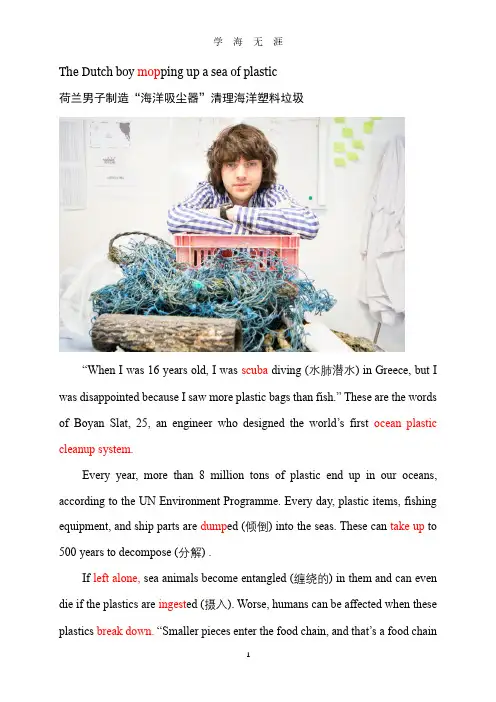
The Dutch boy mop ping up a sea of plastic荷兰男子制造“海洋吸尘器”清理海洋塑料垃圾“When I was 16 years old, I was scuba diving (水肺潜水) in Greece, but I was disappointed because I saw more plastic bags than fish.” These are the words of Boyan Slat, 25, an engineer who designed the world’s first ocean plastic cleanup system.Every year, more than 8 million tons of plastic end up in our oceans, according to the UN Environment Programme. Every day, plastic items, fishing equipment, and ship parts are dump ed (倾倒) into the seas. These can take up to 500 years to decompose (分解) .If left alone, sea animals become entangled (缠绕的) in them and can even die if the plastics are ingest ed (摄入). Worse, humans can be affected when these plastics break down. “Smaller pieces enter the food chain, and that’s a food chainthat includes us humans,” Slat said.In 2018, the World Economic Forum predicted that the weight of ocean plastics will match the weight of all the fish in our oceans by 2050. To prevent this grim (令人沮丧的) reality, Slat created The Ocean Cleanup, an environmental NGO, in 2013 and put his plan for an ocean plastic cleanup device (设备) into action.After years of research and development in the Netherlands, a device called System 001/B successfully started gathering plastic on Oct 2, 2019.The device uses a 600-meter-long “C” shaped tube to gather all the floating debris (垃圾). Unlike other cleanup methods, the system floats freely according to the direction of the waves, which allows waste to flow into and stay within the device.A sea anchor (锚) is attached to either end. This slows down the system as it floats through the water and allows the faster-moving rubbish, carried by the waves, to flow into its mouth. System 001/B can also collect waste below the surface using a 3-meter-deep skirt (挡板) attached to the end. After being gathered, the trash will be dragged back to shore by boat and recycled.In a news conference, Slat said, “In a few years we will have the full-scale fleet (舰队) out there.”Currently, the system operates in the Great Pacific Garbage Patch, an area that is three times the size of France. Once operational, the Ocean Cleanup expects a full fleet to be able to clear 50 percent of the Great Pacific Garbage Patch in fiveyears.It remains to be seen if this dream will become a reality, but it is undeniable that humanity must work together to reduce our plastic use and repair the damage our waste has caused.“We are starting to see a young generation that gets that and is excited about a sustainable (可持续的) future, but the question still comes down to: Are we going fast enough, and how much damage will have been done before we get there?” Slat said.(节选自Telegraph)1. What do the first four paragraphs mainly talk about?A. Slat’s scuba diving experiences in Greece.B. Slat’s research on ocean environments.C. How ocean environment relates to humans.D. How Slat got the idea for an environmental NGO.2. What do we know about System 001/B?A. It’s a cleanup device put into use last October.B. It collects and recycles garbage at the same time.C. It can only collect waste that floats in water.D. It aims to clear the Great Pacific Garbage Patch in a decade.3. What does Slat intend to tell us according to the last paragraph?A. He is positive about the future of the ocean.B. It is hard to repair the damage to the environment.C. Humans should work hard to reduce plastic pollution.D. The younger generation lacks environmental awareness.译文:“当我16岁的时候,我在希腊进行水肺潜水,但我感到失望的是,因为我看到的塑料袋比鱼还要多。
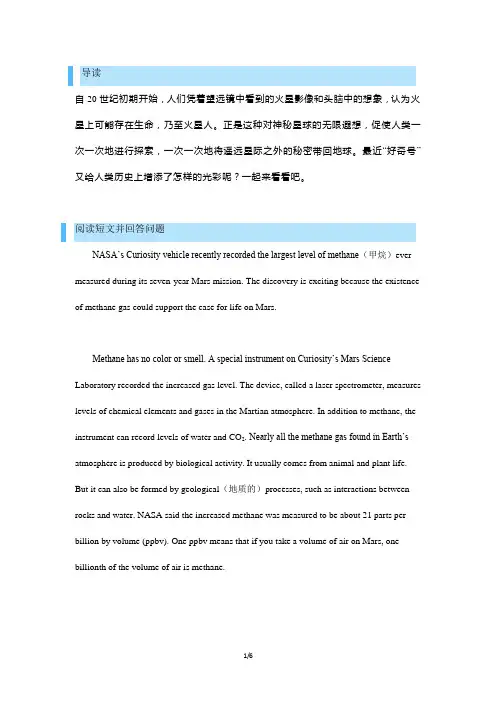
导读自20世纪初期开始,人们凭着望远镜中看到的火星影像和头脑中的想象,认为火星上可能存在生命,乃至火星人。
正是这种对神秘星球的无限遐想,促使人类一次一次地进行探索,一次一次地将遥远星际之外的秘密带回地球。
最近“好奇号”又给人类历史上增添了怎样的光彩呢?一起来看看吧。
阅读短文并回答问题NASA’s Curiosity vehicle recently recorded the largest level of methane(甲烷)ever measured during its seven-year Mars mission. The discovery is exciting because the existence of methane gas could support the case for life on Mars.Methane has no color or smell. A special instrument on Curiosity’s Mars Science Laboratory recorded the increased gas level. The device, called a laser spectrometer, measures levels of chemical elements and gases in the Martian atmosphere. In addition to methane, the instrument can record levels of water and CO2. Nearly all the methane gas found in Earth’s atmosphere is produced by biological activity. It usually comes from animal and plant life. But it can also be formed by geological(地质的)processes, such as interactions between rocks and water. NASA said the increased methane was measured to be about 21 parts per billion by volume (ppbv). One ppbv means that if you take a volume of air on Mars, one billionth of the volume of air is methane.It was not the first time Curiosity has found methane gas in the Martian atmosphere. About a year ago, NASA announced that Curiosity had discovered sharp seasonal increases in the gas. This time, NASA said the measured methane gas level was clearly larger than any others observed in the past. NASA officials even temporarily stopped Curiosity’s other activities to investigate further.“It’s excitin g because microbial(微生物的)life is an important source of methane on Earth,” NASA said in a statement announcing the discovery. However, Curiosity’s team carried out a follow-up methane experiment that showed a sharp drop in levels of the gas. The second examination found the level was less than one part per billion by volume. That number was close to the background levels Curiosity sees all the time. The rise and fall of the methane gas levels left NASA scientists with more questions than answers. The scientists are continuing to study possible causes for the sudden increase. The methane mystery continues.Curiosity does not have instruments that can exactly identify whether the source of the methane is biological or geological. One leading theory is that methane is being released from underground areas created by possible life forms that disappeared long ago. Even though Mars has no active volcanoes, scientists believe it is also possible that methane is being produced by reactions involving carbon materials and water.A clearer understanding of methane levels over time could help scientists determine where they’re located on Mars. Scientists hope this understanding will come as Curiosity continues to collect methane data in its search for possible life.1. Curiosity discovered .A. the largest methane gas level ever on MarsB. the existence of life on MarsC. the reason for the increased methaneD. interactions between rocks and water2.Why did NASA officials once stop Curiosity’s other activit ies?A. To seek possible life existing on Mars.B. To check the quality of Curiosity’s mission.C. To find seasonal increases in the methane gas.D. To further examine the methane gas level on Mars.3.What can we learn from the last three paragraphs?A. Causes for the change of methane have been proved by Curiosity.B. Curiosity has proved the location of methane by instruments.C. Scientists think underground materials’ reactions may produce methane.D. Identifying the source of methane helps scientists search for possible life on Mars.4.The passage is probably taken from .A. a geography textbookB. a science newspaperC. a health magazineD. a travel brochure参考答案1.A 第一段:NASA’s Curiosity vehicle recently recorded the largest level of methane (甲烷)ever measured during its seven-year Mars mission.2.D 第三段NASA officials even temporarily stopped Curiosity’s other activities to investigate further.3.C倒数第二段One leading theory is that methane is being released from underground areas created by possible life forms that disappeared long ago. Even though Mars has no active volcanoes, scientists believe it is also possible that methane is being produced by reactions involving carbon materials and water.4.B 全文介绍“好奇号”发现火星甲烷含量是有史以来的最高值,属于科普类文章,所以可能选自科学杂志。

Why Did Darker and Lighter Human Skin Colors Evolve?为什么我们会有黑色或金色头发呢?The human species started in Africa. To protect ourselves from the harsh and direct sunlight, we evolved with higher levels of melanin in our bodies. This causes darker skin. Dark hair is also a favorable evolution --- less light can pass through dark hair than light, protecting the skin.Over time as the human race migrated, mutation(变异)continued. In the branch that became “white”, mutations that produced paler skin and lighter hair occurred. This was an advantageous mutation because these humans were living in areas with less direct sunlight, so needed to take advantage of the small amounts they were exposed to (we need sunlight to produce vitamin D). Through natural and self-selection, the genes for paler skin and blonde hair survived. Othermutations for lighter hair colors (lighter brown, red) remained for similar reasons.The reason why other races did not evolve blonde hair is as follows: First, they were not given an environmental advantage, so did not increase chances of survival and reproduction. Second, the genes for darker hair colors are dominant over genes for lighter hair color. Without selective pressures (the environment advantage) to encourage this mutation, any spontaneous hair color mutations would be lost in future generations without other recessive genes to allow it to be expressed.Look at it this way --- a few hot blondes randomly showed up in early northern human populations. They used to be healthy, dark-haired humans with a hidden blonde gene. Eventually those dark-haired babies married each other, hidden blonde genes met up, and blonde babies appeared. Blonde babies were just as healthy as dark-haired babies, so the genes became more common.Let’s say the same few blondes showed up in southern human populations. They would burn in the sun and not be able to survive in those conditions. Some dark-haired humans might bang them because they were just lying there ... but they were not ideal mates as they were unhealthy in that environment and could not survive as well. A few babies may have been born with hidden blonde genes, but if a second generation blonde baby was born, they would also struggle to survive in that environment. As a result, blonde genes did not explode.(选自BBC)1. What is the major function of “melanin” in our bodies?A. It prevents us from skin cancer caused by the direct sunlight.B. It helps people to evolve throughout the human history.C. It helps people with the mutation process during migration.D. It makes our body darker to protect us from sunlight.2. What can we infer from the passage?A. People with pale skin can survive better in places with direct sunlight,B. People’s genes mutate with the change of the environment.C. All vitamins are produced with the help of sunlight exposure.D. Without the environmental advantage, the gene of blonde hairs can never be expressed.3. Why is there less blonde-haired population in southern places?A. Southern people do not have the genes of blonde hair.B. People with blonde hair can hardly survive in southern places.C. Immigration has quickened the mutation process.D. Blonde hair can hardly attract ideal mates in southern places.4. What is this passage mainly about?A. Why difference races have different colors in skin and hair.B. Why most Africans have been dark in color since ancient.C. How evolution matters in the history of human civilization.D. The differences between the northern and southern people in hair color.译文:人类起源于非洲。
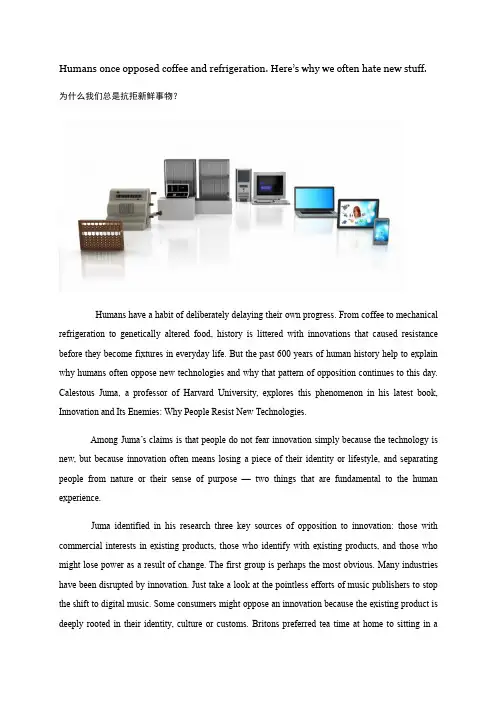
Humans once opposed coffee and refrigeration.Here’s why we often hate new stuff.为什么我们总是抗拒新鲜事物?Humans have a habit of deliberately delaying their own progress.From coffee to mechanical refrigeration to genetically altered food,history is littered with innovations that caused resistance before they become fixtures in everyday life.But the past600years of human history help to explain why humans often oppose new technologies and why that pattern of opposition continues to this day. Calestous Juma,a professor of Harvard University,explores this phenomenon in his latest book, Innovation and Its Enemies:Why People Resist New Technologies.Among Juma’s claims is that people do not fear innovation simply because the technology is new,but because innovation often means losing a piece of their identity or lifestyle,and separating people from nature or their sense of purpose—two things that are fundamental to the human experience.Juma identified in his research three key sources of opposition to innovation:those with commercial interests in existing products,those who identify with existing products,and those who might lose power as a result of change.The first group is perhaps the most obvious.Many industries have been disrupted by innovation.Just take a look at the pointless efforts of music publishers to stop the shift to digital music.Some consumers might oppose an innovation because the existing product is deeply rooted in their identity,culture or customs.Britons preferred tea time at home to sitting in acoffee shop,for example.Finally,the emergence of new technologies can also result in a shift in economic and political power,redistributing wealth and influence away from some groups,and toward others.The expansion of tractors(拖拉机)and other mechanical equipment reduced the need for farm labor,and the shift in population away from rural areas had significant political implications.Humans make decisions about new innovations with their instinct rather than evidence. Opponents and enthusiasts of a new technology will often make shocking claims to support their arguments.Sometimes these claims are rooted in fact;other times they are not.People once claimed coffee could make you sterile(不育的).Juma said beneath those arguments was typically an instinctive fear of new technologies,rather than a reasoned response.“People react intuitively,and they collect the evidence to support what they’re doing,”Juma said.“They see a new product and there is an emotional reaction to that product because it challenges their outlook on the world.This has been the story with almost every new product.”Historically,technologists have been more concerned with the functionality of the products they create,paying less attention to the implications it may have on society at large,Juma contends. Fortunately,that may be starting to change.(选自Washingtonpost)43.We can infer from the first two paragraphs that Juma’s book____.A.explores why history often repeats itselfB.focuses on the impact of technology on natureC.analyzes the role of technology in social progressD.researches the recurrence(重现)of a certain phenomenon44.Which of the following statements is correct according to Paragraph3?A.Opposition to innovation is mainly caused by loss of cultural identity.B.British people have a strong sense of independence.C.A successful technological innovation can affect population flow.D.Young people prefer digital music to traditional recordings.45.In Juma’s opinion,people’s resistance to new technologies____.A.is not based on factB.is a natural responseC.arises from fear of challengesD.reflects their prejudiced view of the world46.It is implied in the last paragraph that technologists should give more consideration to____.A.the functionality of new productsB.the social usefulness of new productsC.the social influence of new productsD.the potential danger of new products译文:人类习惯于故意拖延自己的进步。
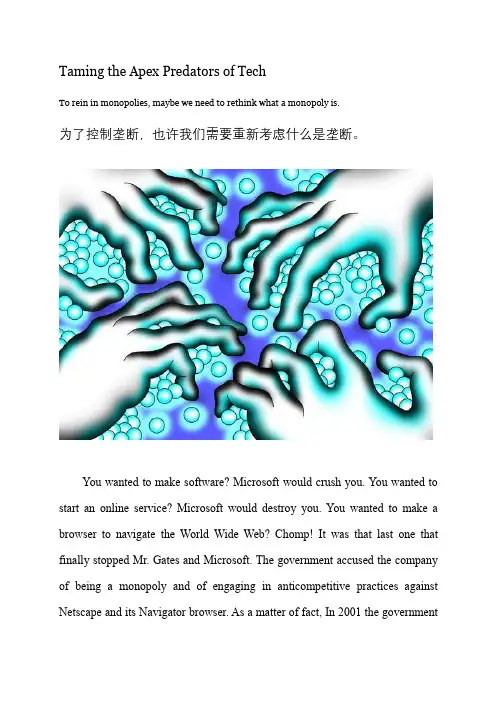
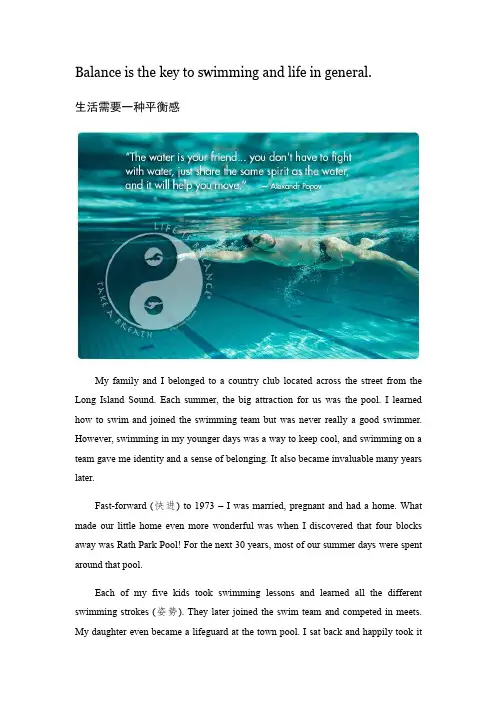
Balance is the key to swimming and life in general.生活需要一种平衡感My family and I belonged to a country club located across the street from the Long Island Sound.Each summer,the big attraction for us was the pool.I learned how to swim and joined the swimming team but was never really a good swimmer. However,swimming in my younger days was a way to keep cool,and swimming on a team gave me identity and a sense of belonging.It also became invaluable many years later.Fast-forward(快进)to1973–I was married,pregnant and had a home.What made our little home even more wonderful was when I discovered that four blocks away was Rath Park Pool!For the next30years,most of our summer days were spent around that pool.Each of my five kids took swimming lessons and learned all the different swimming strokes(姿势).They later joined the swim team and competed in meets. My daughter even became a lifeguard at the town pool.I sat back and happily took itall in!As much as I would have liked to have life stand still,it doesn’t.My children outgrew their pool days and moved on.But the pool was still four blocks from my home,so I began to take up swimming again.And it was far better than I ever could have imagined.I got so much out of it that I joined the local pool so I could swim year-round.Whenever I swam,I would always come out feeling physically and mentally refreshed.I often felt that if I looked hard enough,I would be able to see all of the worries and problems I’ve had in life,sitting at the bottom of the pool!What has swimming taught me?I’ve learned that balance is the key to being a good swimmer.If you are balanced in the water,you have no resistance.Working on staying balanced made me realize the similarities between life in and out of the swim lane(泳道).If you work on keeping yourself balanced,you will be able to swim right through the stress and problems life throws at you!(选自Reader’s Digest)1.What can we learn about the author from Paragraph1?A.Her family taught her how to swim.B.She swam with friends more often in summer.C.Swimming brought her lifelong benefits.D.She was elected to be the swim team captain.2.What does the underlined sentence in Paragraph4imply?A.The author loved the pool days with her kids.B.Swimming was losing its appeal to the author.C.Her kids’winning competitions made her proud.D.The author preferred to have a peaceful life.3.What did the author find after she took up swimming again?A.Sports can give you the courage to face difficulties.B.She mastered more swimming skills than expected.C.It enabled her to see how to handle problems in life.D.Swimming made her remember her younger days.4.What is the main idea of the article?A.The wonderful pool days with the author’s family.B.The influence of swimming on the author’s life.C.The physical and mental benefits of swimming.D.The similarities between swimming and life.译文:我和我的家庭在一个位于长岛之声街对面的乡村俱乐部。
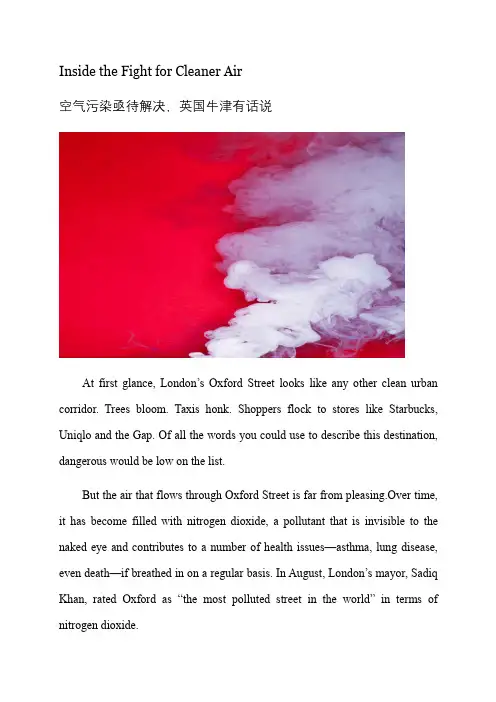
Inside the Fight for Cleaner Air空气污染亟待解决,英国牛津有话说At first glance,London’s Oxford Street looks like any other clean urban corridor.Trees bloom.Taxis honk.Shoppers flock to stores like Starbucks, Uniqlo and the Gap.Of all the words you could use to describe this destination, dangerous would be low on the list.But the air that flows through Oxford Street is far from pleasing.Over time, it has become filled with nitrogen dioxide,a pollutant that is invisible to the naked eye and contributes to a number of health issues—asthma,lung disease, even death—if breathed in on a regular basis.In August,London’s mayor,Sadiq Khan,rated Oxford as“the most polluted street in the world”in terms of nitrogen dioxide.This is not the narrative we’re used to hearing about air pollution,which for years has been associated with obvious markers,like fumes and smog,in developing countries.Now,however,it affects everyone.A recent report from the World Health Organization(WHO)estimates that roughly9out of10people live in areas with excessive air pollution.How did things get so bad?The answers depend on where you live.In the developing world,the main culprit is rapid industrial growth,which has led to the creation of dirty factories and coal-fired power plants.In Europe,it’s mostly the rise of diesel-powered cars,which emit nitrogen dioxide.Globally,though, lawmakers have lately ignored the problem until it arrives at their doorstep.Slowly,that’s starting to change.In London,Oxford Street and other polluted roads will soon be permanently car-free.In Los Angeles,transit officials have cited air pollution as a key driver behind a move to electric buses. Many policymakers hope measures to address climate change,like last year’s Paris Agreement,will also help reduce pollution.These moves represent an important start,but a real push to clean the air will take years if not decades.The biggest barrier to such efforts may be the cost, real or imagined.Developing countries rely on factories to fuel growth,and officials have long feared that breaking that habit may hurt their economies.In the meantime,a group of scientists,environmentalists and entrepreneursare trying to tackle the problem on their own.Among them:Vogmask and Cambridge Mask Co.,which offer stylish versions of the N95air-filtration mask, and TZOA,whose Fitbit-like device allows users to track the air quality around them in real time.Of course,these efforts are treating the symptoms,not the problem.But for many,that’s better than nothing.(选自TIME)1.Which of the following statements is true according to the passage?A.Traditional air pollution markers include fumes,smog and nitrogen dioxide.B.London’s Oxford Street was rated as the most polluted place in the world.C.Many health issues in London are attributed to the traffic in Oxford Street.D.Now air pollution affects only those in developing countries.2.The underlined word“culprit”can be replaced with“A.reasonB.resultC.targetD.interest3.All the following are contributing factors to the seriousness of airpollution exceptA.dirty factories and coal-fired power plants in developing countriesB.some tourist destinations filled with visitorswmakers’failure to address the problem before it’s too lateD.the rise of diesel-powered cars in European countries4.From the last paragraph,we can infer thatA.developing countries lag behind in their efforts to deal with air pollutionB.some companies have already come up with effective measures to deal with air pollutionC.scientists,environmentalists and entrepreneurs have made vain effortsD.although current efforts cannot resolve air pollution directly,they are worth making译文:乍一看,伦敦的牛津街看起来就像其他任何干净的城市走廊一样。
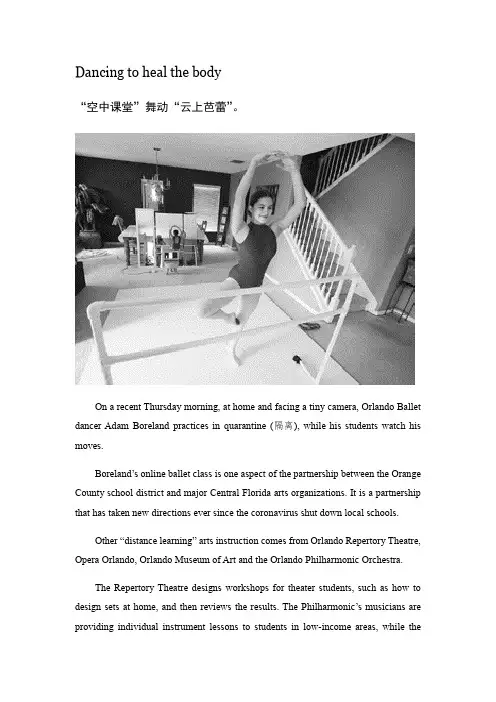
Dancing to heal the body“空中课堂”舞动“云上芭蕾”。
On a recent Thursday morning, at home and facing a tiny camera, Orlando Ballet dancer Adam Boreland practices in quarantine (隔离), while his students watch his moves.Boreland’s online ballet class is one aspect of the partnership between the Orange County school district and major Central Florida arts organizations. It is a partnership that has taken new directions ever since the coronavirus shut down local schools.Other “distance learning” arts instruction comes from Orlando Repertory Theatre, Opera Orlando, Orlando Museum of Art and the Orlando Philharmonic Orchestra.The Repertory Theatre designs workshops for theater students, such as how to design sets at home, and then reviews the results. The Philharmonic’s musicians are providing individual instrument lessons to students in low-income areas, while theopera company is leading master classes (大师讲堂) for choral students and teaching performance tips. The art museum creates educational programming for both elementary and secondary students.Across the district, roughly 5,900 students study dance in about 25 programs, according to Scott Evans, director of the school district’s fine arts curriculum. The goal is to let as many as possible attend an Orlando Ballet class.Boreland’s class includes students from Apopka, Freedom, University, Wekiva and Windermere High, as well as Timber Creek. “We’re stuck inside. You really want to emote and heal the body through dance,” Boreland tells them.He also gives online dance feedback. “Keep the foot connected to the floor,” he says. “Don’t change the hips; save it for hip-hop class.”Sophomore Alessandra Lozzi, a two-year member of the Timber Creek dance team, appreciates the chance to “soak up (吸收) information” from Boreland. “His technique, his passion for dancing ... I love it,” she said.The instruction and interaction help the ballet company with its mission of reaching out to the community, said Orlando Ballet School director Phillip Broomhead.“It’s tremendous (绝妙的) that we are able to collaborate,” he said. “It’s giving the students a glimpse of people living the dream right now.”Boreland’s class ends with students’ thank-you comments flooding the online chat window.Lozzi, who hopes to dance professionally one day, can’t wait for another session. “It’s inspiring,” she said.(选自Reader’s Digest)1. Which of the following art organizations provides lessons for students in poor areas?A. Opera Orlando.B. Orlando Ballet.C. Orlando Repertory Theatre.D. The Orlando Philharmonic Orchestra.2. How does Boreland give ballet lessons during quarantine?A. He gives individual lessons to students online.B. He teaches ballet and gives feedback online.C. He teaches ballet and gives tips on quarantined life.D. He asks students to follow his previously recorded lessons.3. How are Boreland’s online ballet lessons according to the text?A. They help students kill boredom in quarantine.B. More teacher-student interaction is expected.C. They are well received by the students.D. They inspire students to contribute to their community.译文:在最近的一个星期四的早晨,奥兰多芭蕾舞团的舞蹈演员亚当·鲍兰面对着一台微型相机,在隔离区练习隔离,而他的学生们则在观察他的动作。
China's booming coffee culture has significant impacts on the global market 中国迅速兴起的咖啡文化对全球市场有着至关重要的影响Sun was sitting at a table under a green parasol(大遮阳伞),enjoying an iced coffee while waiting for her friend.The sun was shining and the seating area outside the Starbucks in Xintiandi was full of young,fashionable Chinese.Sun is one of a growing number of Chinese people starting to drink coffee regularly and helping to make the Chinese coffee market the fastest growing one in the world.China may be historically a nation of tea drinkers,but in recent years,coffee has become increasingly popular,particularly among younger people in big cities.International coffee chains like Starbucks and Costa can now be found in almost every big Chinese city.Both brands see China as a huge growth market and have tried to adapt to Chinese tastes.Starbucks,which opened its first Chinese shop in1999,has said it plans to double its store count in China to over3,000stores by2019,while Costa plans to expand itself to900shops by2020.“Coffee culture has been developing in China,”says Esther Lau,a market research analyst.China’s massive and rapid urbanization,along with a growing number of Chinese traveling overseas,are the major factors she believes that have contributed to the development of coffee drinking.However,coffee remains a relatively new departure for China’s tea-drinking population.While coffee is an everyday purchase for most office workers in the West,it is still considered a premium(优质的)product in China and is a luxury out of the reach of most average workers.At the Starbucks in Xintiandi,for example,a medium latte costs30yuan.A high price is considered a sign of quality in China,says Lau.“The higher the price, the better the quality.This concept remains popular in China,and Starbucks and Costa have both realized it,”she adds.“They want to brand themselves as premium chains.”China is also growing as a producer of coffee,with the majority grown in Yunnan,a province traditionally associated with tea production.Over the past five years,the annual production volume of coffee there has increased from60,000tons to nearly120,000tons.(节选自the Guardian)1.Esther Lau attributes the development of coffee drinking in China to the factthat_______.①an increasing number of towns and cities have popped up in China②an increasing number of Chinese people can now lead a wealthy life③an increasing number of Chinese have taken to traveling overseas④an increasing number of international coffee chains have appeared in ChinaA.①③B.②④C.①④D.②③2.Starbucks and Costa charge high prices for their products because_________.A.the coffee beans they use cost them a lot of moneyB.they want to make up for their losses in the WestC.most of their target customers are very wealthyD.they want to brand themselves as premium chains3.We can find answers to all of the following questions in the articleEXCEPT“_________”A.What is the fastest growing coffee market in the world?B.When did Costa open its first coffee shop in China?C.How much is a medium latte at the Starbucks in Xintiandi?D.How many coffee beans does Yunnan produce every year?词汇:adapt v.to gradually change your behavior and attitudes in order to be successful in a new situation适应,适合urbanization n.the process by which more and more people leave the countryside to live in cities 城市化过程contribute v.to help to make sth.happen促成,造成答案:1.A 2.D 3.B。
Do big sporting events make us do more sport?大型体育赛事真的会促使我们做更多的运动吗?I recently spent half aweekend sitting on the sofa watchingthe Davis Cup.I thought about goingfor a run,but I did not want to missthe rest of the match.Soon it wasstarting to get dark,so I did not bother.Whenever I watch tennis,I think hownice it would be to play it regularly.But I have been thinking that for almost20years without actually setting foot on a court.The evidence would suggest that I’m not the only one.When a country or city bids to host an international sporting event,it often promises that more people will take up sports as a result.London was no exception.Tessa Jowell,who helped to secure the2012Olympics for London,said they would be the first to set challenging but achievable targets as a measure of their ambition:By2012two million more people would be physically active.And60percent of young people would be doing at least five hours of sports per week.In the end it did not turn out quite like that.Just over one-third of people in Britain take part in sports once a week.A report on Olympic and Paralympic legacy has said that a big change in participation levels simply has not happened.Why isn’t there a big increase in people taking part in sports after most sporting events? Perhaps it is a mistake to assume an automatic link between watching sports and playing it.While the games are on,they actually encourage people to do just the opposite—to spend whole sunny days not out playing sports,but inside sitting on the sofa with the curtains shut to stop the sun shining on the TV screen and spoiling the view.We don’t expect half the audience of a hit musical to apply to drama school the next day,yet we seem to expect it of sporting events.We might have sat on the sofa doing an impression of Usain Bolt’s bow-and-arrow signature pose.But how many of us have been inspired by watching him sprint(短跑)100meters? The high-level performances on show only remind people that they could never match the elite athletes in their sporting achievements even if they trained full time.Maybe participation in sports is not the right legacy to expect after a major sporting event. It’s not so much that the Olympics failed to get people to participate but rather that this was never going to be the result.The Olympics can do many things,but maybe this cannot necessarily be one of them.(节选自BBC)1.What can we learn from the first paragraph?A.The author prefers playing tennis to running.B.The author watches tennis matches very rarely.C.The author hasn’t played tennis in nearly two decades.D.The author didn’t go for a run because the match lasted longer than expected.2.The underlined word“secure”in Paragraph2probably means“_________A.to fastenB.to protectC.to obtainD.to promise3.According to the article,there is no noticeable rise in sport participation after most events because.①it takes people a longer time to play sports than watch it②watching sports actually discourages people from going out③sporting events make people aware that they could never be as good as elite athletes④people are too busy to get into the habit of taking part in sportsA.①②B.②③C.③④D.①④4.According to the author,to expect more citizens to play sports after a country hosts the Olympics is.A.importantB.naturalC.harmfulD.unnecessary词汇:bother v.to make the effort to do sth.费心,麻烦evidence n.facts or signs that show clearly that sth.exists or is true.证据,证明legacy n.sth.that happens or exists as a result of things that happens at an earlier time.遗留物语法:It’s not so much that the Olympics failed to get people to participate but rather that this was never going to be the result.not so much as...as...是一个固定短语,意为“与其说是...不如说是...”。
Man’s best friend我最爱的汪星人,我最爱的狗狗I woke up with drool(口水)on my pillow this morning.I wouldn’t have minded except it wasn’t mine.The alarm clock rang,and I reached over to turn it off.As I laid my face back down on the pillow,I felt the wet,slimy(黏滑的)drool on my pillow case.I opened my eyes and saw a smiling,panting(喘气的),furry face gazing down at me.I tried to get up,but she was too fast.My face was suddenly covered in kisses with one going straight up my nose and another right in my ear.I laughed,reached out and picked up the eight-pound love machine and held her away from my dripping(湿透的)face.It was just another morning in a life with dogs.Why do we welcome them into our homes and our hearts?We know that we are most likely going to outlive them and have our hearts broken when they age quickly and pass away after ten to fifteen years.We know that there will be vet(兽医)bills, flea baths and enough fur to make a vacuum cleaner cry.We know that our ears will ring from the barking,that we will be picking up poop(大便)every single day andthat we will never get to finish a full sandwich again.Yet,when we are feeling down or blue,there will always be a soft head on our lap needing to be pet.When we get home after a long day’s work,there will be a happy face at the door waiting for us.Our lives will be full of balls to throw,bellies (腹部)to scratch,and love and loyalty that will warm our hearts and uplift our souls.For thousands of years,dogs have been our best friends.They remain one of the greatest gifts life has ever given us.Even if they can’t love us for the rest of our lives, they will always love us for all of theirs.(选自Reader’s digest)1.How does the author probably feel about his dog every morning?A.Awful.B.Impatient.C.Delighted.D.Thrilled.2.What figure of speech(修辞手法)is used for the underlined sentence in Paragraph2?A.Irony.B.Contrast.C.Repetition.D.Personification.3.The purpose of Paragraph2is to______.A.explore why we adore dogsB.show the burden dogs can bringC.give examples of dogs’bad behaviorD.list reasons why some people avoid dogs4.What does the last sentence of this article mean?A.Dogs are devoted to their owners.B.Dogs’owners outlive them.C.Life is never perfect.D.Dogs are beneficial.5.The writer wrote this article mainly to______.A.give the advantages and disadvantages of raising dogsB.share how much love his dog has brought himC.say that keeping a dog is worth all the troubleD.analyze the impact of a dog’s company译文:今天早上闹钟响了,我伸手把它关了。
Don’t always believe what scientists and other authorities tell you!不要总是相信科学家们告诉你的事Don’t always believe what scientists and other authorities tell you! Be skeptical! Think critically! That’s what I tell my students. Early in my career, I was a conventional science writer, easily impressed by scientists’ claims. But doubt gradually weakened my faith. Scientists and journalists, I realized, by continuously boasting scientific “advances”—from theories of cosmic (宇宙的) creation and the origin of life to the latest treatments for depression and cancer, made science seem more powerful and fast-moving than it really is. Now, I urge my students to doubt the claims of some scientists. This isn’t science anymore; Ideclare in class, it’s only science fiction with equations! To drive this point home, I assign articles by John Ioannidis, an epidemiologist who has exposed the weakness of most peer-reviewed research. In a 2005 study, he concluded that “most published research findings are false.”So how do my students respond to my skeptical teaching? Some react with healthy pushback, especially to my suggestion that the era of really big scientific discoveries might be over. “On a scale from toddler knowledge to ultimate enlightenment, man’s understanding of the universe could be anywhere,” wrote a student named Matt. “How can a person say with certainty that everything is known or close to being known if it is incomparable to anything?”Other students embrace skepticism to a degree that shocks me. Cecelia, a biomedical-engineering major, wrote: “I am skeptical of the methods used to collect data on climate change, the analysis of this data, and the predictions made based on this data.” Pondering (思索) the lesson that correlation does not equal causation, Steve questioned the foundations of scientific reasoning. “How do we know there is a cause for anything?” he asked.In a similar way, some students echoed the claim of radical (激进的) postmodernists that we can never really know anything for certain, and hence that almost all our current theories will probably be overturned. Just as Aristotle’s physics gave way to Newton’s, which in turn yielded to Einstein’s, so our current theories of physics will surely be replaced by completely different ones.After one especially harsh paper, I responded, “Whoa!” Science, I lectured sternly, has established many facts about reality beyond a reasonable doubt, embodied by quantum mechanics, general relativity, the theory of evolution, the genetic code. This knowledge has yielded applications—from vaccines to computer chips—that have transformed our world in countless ways. It is precisely because science is such a powerful mode of knowledge, I said, that you must treat new pronouncements skeptically, carefully distinguishing the genuine from the false. But you shouldn’t be so skeptical that you deny the possibility of achieving any knowledge at all.My students listened politely, but I could see the doubt in their eyes. We professors have a duty to teach our students to be skeptical. But we also have to accept that, if we do our jobs well, their skepticism may turn on us.(选自researchgate)1. Why was the author’s faith in science weakened?A. Because some essays from his peer scholars cast strong doubt on science.B. Because scientists often presented an overly optimistic picture of science.C. Because he was tired of reading too much science fiction with equations.D. Because an academic figure claimed that most published research findings were false.2. Which of the following was NOT one of the students’ responses to the author’s skeptical teaching?A. Some doubted his suggestion of the limitation of scientific discoveries.B. Some questioned the way of data collecting and scientific reasoning.C. Some launched harsh criticism against the author’s advocacy of skepticism.D. Some claimed there was no certainty for any established theory.3. What did the author think of his students’ responses?A. He considered them as a display of their creativity.B. He viewed them a must in order to understand the spirit of science.C. He treated them as an extreme application of skepticism.D. He regarded them as a kind of respect paid by students to their teacher.4. Which might be the best title for this article?A. When Teaching Critical Thinking BackfiresB. Skepticism Makes Teaching More FunC. No Doubt, No ScienceD. Students Turn Out Better Than Teacher译文:不要总是相信科学家和其他权威人士告诉您的内容!持怀疑态度!认真思考!我就是这么告诉我的学生的。
Programming pain日本制造出能感知疼痛的机器人。
Robots are useful because they never get tired and can’t feel pain.Why program robots to feel pain?Some researchers,however,believe it’s a good idea.Researchers from Leibniz University of Hannover in Germany are working to develop an“artificial(人工的)robot nervous system to teach robots how to feel pain”,according to IEEE Spectrum.“Pain is a system that protects us,”said Johannes Kuehn,one of the researchers.“When we evade(规避)from the source of pain,it helps us not get hurt.”Think about how many injuries you would receive if you couldn’t feel pain.Even though pain hurts,it helps us to avoid danger and treat our wounds.The same will be true for robots. As a greater number of people work closely with robots,the robots must behave in a safer manner.Kuehn believes that by protecting robots from damage,they’ll be protecting people as well.Damage to robots–if left unseen–could lead to workplace accidents.Rather than feel pain,some robots are designed to show pain or see it in others.Minoru Asada,an engineer at Osaka University in Japan,and his colleagues have made sensors(传感器)that pick up many types of touch signals.These touch and pain signals can turn intoemotions and expressions on a robot’s face.Asada believes that these systems could eventually lead to robots seeing the pain on human faces,an important skill for robots designed to care for elderly people,for example.Antonio Damasio,a neuroscientist(神经学家)at the University of Southern California, argues that programming robots with a sense of pain(or something similar)may cause an artificial sense of feeling to develop.A robot with touch sensors that can detect(探测)pain is “along the lines of having a robot,for example,that smiles when you talk to it”,Damasio said.“It’s a device for communication of the machine to a human.”Damasio is quick to point out that this communication is an interesting development,but “it’s not the same thing”as a robot truly feeling and expressing emotions or pain.If one day, robots could actually feel as humans do,Damasio has a suggestion for the number one rule for robots:Feel good.(选自The Telegraph)1.Why would a robot nervous system be beneficial,according to Kuehn?A.It could help robots treat humans’injuries gently.B.It could reduce accidents when robots work.C.It could teach robots how to find a source of danger.D.It could let robots respond more quickly to instructions.2.What could the sensors developed by Asada and his colleagues be used for in the future?A.Collecting various types of touch signals.B.Turning human emotions into touch signals.C.Helping robots recognize the pain on human faces.D.Showing robots how to take care of the elderly.3.What is Damasio’s attitude toward this technology?A.It could promote interaction between humans and robots.B.It will eventually allow robots to feel as humans do.C.It will be hard to translate the artificial sense of feelings.D.It could lead to real human-robot emotional connections.译文:机器人之所以有用,是因为它们永远不会累,也不会感到疼痛。
The Dutch boy mop ping up a sea of plastic荷兰男子制造“海洋吸尘器”清理海洋塑料垃圾“When I was 16 years old, I was scuba diving (水肺潜水) in Greece, but I was disappointed because I saw more plastic bags than fish.” These are the words of Boyan Slat, 25, an engineer who desi gned the world’s first ocean plastic cleanup system.Every year, more than 8 million tons of plastic end up in our oceans, according to the UN Environment Programme. Every day, plastic items, fishing equipment, and ship parts are dump ed (倾倒) into the seas. These can take up to 500 years to decompose (分解) .If left alone, sea animals become entangled (缠绕的) in them and can even die if the plastics are ingest ed (摄入). Worse, humans can be affected when these plastics break down.“Smaller pieces enter the food chain, and that’s a foodchain that includes us humans,” Slat said.In 2018, the World Economic Forum predicted that the weight of ocean plastics will match the weight of all the fish in our oceans by 2050. To prevent this grim (令人沮丧的) reality, Slat created The Ocean Cleanup, an environmental NGO, in 2013 and put his plan for an ocean plastic cleanup device (设备) into action.After years of research and development in the Netherlands, a device called System 001/B successfully started gathering plastic on Oct 2, 2019.The device uses a 600-meter-long “C” shaped tube to gather all the floating debris (垃圾). Unlike other cleanup methods, the system floats freely according to the direction of the waves, which allows waste to flow into and stay within the device.A sea anchor (锚) is attached to either end. This slows down the system as it floats through the water and allows the faster-moving rubbish, carried by the waves, to flow into its mouth. System 001/B can also collect waste below the surface using a 3-meter-deep skirt (挡板) attached to the end. After being gathered, the trash will be dragged back to shore by boat and recycled.In a news conference,Slat said, “In a few years we will have the full-scale fleet (舰队) out there.”Currently, the system operates in the Great Pacific Garbage Patch, an area that is three times the size of France. Once operational, the Ocean Cleanup expects a full fleet to be able to clear 50 percent of the Great Pacific GarbagePatch in five years.It remains to be seen if this dream will become a reality, but it is undeniable that humanity must work together to reduce our plastic use and repair the damage our waste has caused.“We are starting to see a young generation that gets that and is excited about a sustainable (可持续的) future, but the question still comes down to: Are we going fast enough, and how much damage will have been done before we get there?” Slat said.(节选自Telegraph)1. What do the first four paragraphs mainly talk about?A. Slat’s scuba diving experiences in Greece.B. S lat’s research on ocean environments.C. How ocean environment relates to humans.D. How Slat got the idea for an environmental NGO.2. What do we know about System 001/B?A. It’s a cleanup device put into use last October.B. It collects and recycles garbage at the same time.C. It can only collect waste that floats in water.D. It aims to clear the Great Pacific Garbage Patch in a decade.3. What does Slat intend to tell us according to the last paragraph?A. He is positive about the future of the ocean.B. It is hard to repair the damage to the environment.C. Humans should work hard to reduce plastic pollution.D. The younger generation lacks environmental awareness.译文:“当我16岁的时候,我在希腊进行水肺潜水,但我感到失望的是,因为我看到的塑料袋比鱼还要多。
”这就是25岁的博扬·斯拉特的话。
第一个海洋塑料清理系统。
根据联合国环境规划署的数据,每年有超过800万吨的塑料最终进入我们的海洋。
每天,塑料物品,捕鱼设备和船舶零件都被倾倒入海。
这些可能需要多达500年的时间才能分解。
如果放任不管,海洋动物就会纠缠在其中,甚至在摄入塑料的情况下也可能死亡。
更糟糕的是,当这些塑料分解时,人类会受到影响。
斯拉特说:“更小的零件进入了食物链,这就是包括我们人类在内的食物链。
”在2018年,世界经济论坛预测,到2050年,海洋塑料的重量将与我们海洋中所有鱼类的重量相匹配。
为防止这种令人沮丧的现实,Slat创立了环保非政府组织The Ocean Cleanup,在2013年将他的海洋塑料清理装置(设备)计划付诸实施。
在荷兰进行了多年的研发之后,一种名为System 001 / B的设备于2019年10月2日成功开始收集塑料。
该设备使用600米长的“ C”形管收集所有漂浮的垃圾(垃圾)。
与其他清理方法不同,系统会根据波浪的方向自由漂浮,从而使废物流入并留在设备中。
一个海锚附接到任一端。
当系统漂浮在水中时,这会减慢系统的速度,并允许波浪携带的移动速度更快的垃圾流入其嘴中。
系统001 / B还可以使用附着在末端的3米深裙边(挡板)收集表面以下的废物。
收集后,垃圾将通过船拖回岸上并进行回收。
斯拉特在新闻发布会上说:“几年后,我们将拥有完整的舰队。
”目前,该系统在大太平洋垃圾场运行,该区域的面积是法国的三倍。
一旦投入使用,海洋清理工作预计整个船队将能够在五年内清除大太平洋垃圾场的50%。
这个梦想是否会成真还有待观察,但是不可否认的是,人类必须共同努力减少塑料的使用并修复我们的废物造成的破坏。
“我们开始看到年轻的一代能够做到这一点,并对可持续的可持续发展感到很棒,但问题仍然归结为:我们的发展速度是否足够快,以及在我们获得成功之前将遭受多少损失?斯莱特说。
背景信息:The plastic we use every day ends up in three main ways in the oceans:Throwing plastic in the bin when it could be recycledPlastic you put in the bin ends up in a landfill (填埋地). When transported to a landfill, plastic is often blown away because it’s so lightweight.LitteringLitter dropped on the street doesn’t stay there. Rainwater and wind carry plastic waste into streams and rivers, and down drains (下水道). Drains lead tothe ocean.Products that go down the drainMany of the products we use daily are flushed (冲) down toilets and sinks, then out into the ocean.我们每天使用的塑料最终会以三种主要方式进入海洋:可回收利用的塑料被扔进垃圾箱中您放入垃圾箱中的塑料最终被填埋了。